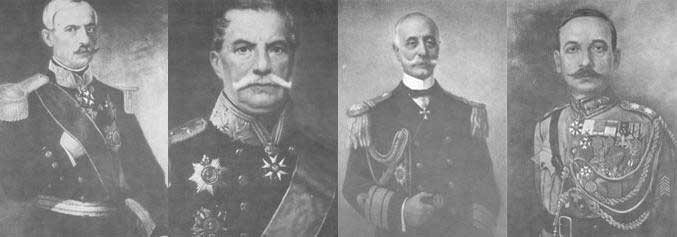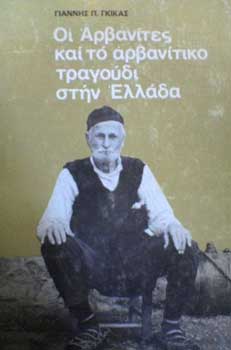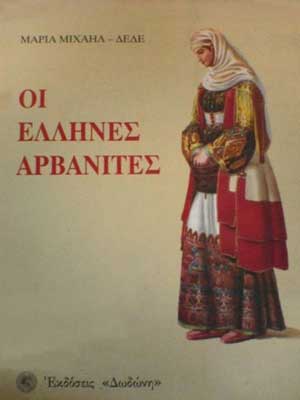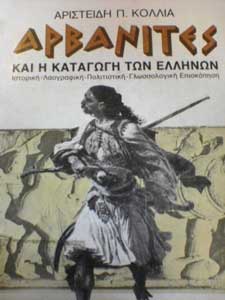.

Arvanites: From left to right: Athanasios Miaoulis (1815 - 1867), Antonios Kriezis (1796 - 1865), Pavlos Kountouriotis (1855 - 1935) and Theodoros Pangalos (1878 - 1952).
Arvanites (Greek: Αρβανίτες, see below for more about names) are a population group in Greece whose linguistic heritage is Arvanitic, a form of Albanian. Arvanites are predominantly Greek Orthodox Christians and identify themselves ethnically and nationally as Greeks. They used to be the predominant population element in several regions in the south of Greece up to the 19th century. Today, their language is under danger of extinction due to language shift towards Greek and due to large-scale migrations into the cities.
Foreign sources sometimes refer to Arvanites as Albanians,[1] as did some older Greek authors.[2] Today, however, Arvanites in Greece typically object to being associated with the Albanian nation or being called an "ethnic minority", since they have a strong feeling of being ethnically Greek (GHM 1995). For the same reason, many also object to the designation of their language as a dialect of Albanian, preferring instead to regard it as a separate language. Many Albanians, on the other hand, prefer to view Arvanites as an Albanian minority group.
History
Arvanites in the south of Greece are believed to be the descendants of Albanian-speaking settlers, who moved south at different times between the 11th century and the 15th century from what is today southern Albania and northwest Greece (Biris 1960, Poulos 1950, Panagiotopulos 1985). Some of this migration happened in the course of settlement programmes invited by the Byzantine and Frankish rulers of the time in order to re-populated deserted areas in the south. Later movements are believed to have been motivated to evade Islamization after the Ottoman conquest.
While most historians regard the ancestors of today's Arvanites as part of the same medieval population groups that are also the ancestors to present-day Albanians,[3] some Greek authors have argued that the settlers were not ethnic Albanians in a true sense. Their hypotheses are that Arvanites were either descendants of originally Greek populations who had only intermediately become Albanized; or that they were descendants of some other Thraco-Illyrian tribes and as such related but not identical to Albanians proper;[citation needed] or that Arvanites are descendants of the original pre-Greek "Pelasgian" population and as such actually autochthonous to southern Greece.[4]
Being Orthodox Christians, Arvanites identified with the Greeks in their conflicts with Muslim during the time of the Ottoman Empire. Many Arvanites are credited with having played an important role fighting as Greeks in the Greek War of Independence of 1821-1830. With the formation of modern nations and nation states in the Balkans, Arvanites have come to be regarded as an integral part of the Greek nation.
Demographics

Photograph of an Arvanite.
The regions traditionally inhabited by Arvanites in the south of Greece are found across large parts of Attica, Boeotia, the Peloponnese, the south of the island of Euboea and the north of the island of Andros. Within Attica, the capital Athens and its suburbs were partly Arvanitic until the late 19th century. There are also settlements in Fthiotida, Lokrida and several islands of the Saronic Gulf including Salamis.
Other groups of Arvanites live in the north of Greece in areas closer to Albania and the historical centers of contiguous Albanian populations (Banfi 1996). Some of them live in Epirus (Thesprotia and Preveza); in Florina/Konitsa (near the border of the Republic of Macedonia); and in some locations further east in Thrace. These settlements are believed to be of a later date than the southern ones (GHM 1995).
There are no reliable figures about the number of Arvanites in Greece today. The last official census figures available come from 1951. The following is a summary of the widely diverging estimates (Botsi 2003: 97):
1928 census: 18,773 citizens self-identifying as "Albanophone", i.e. Arvanitic-speaking.
1951 census: 22,736 "Albanophones".
Furikis (1934): estimated 70,000 Arvanites only in Attica.
Trudgill/Tzavaras (1976/77): estimated 140,000 only in Attica and Boeotia.
- Sasse (1991): estimated 50,000 Arvanitic speakers in total.
- Ethnologue, 2000: 150,000 Arvanites, living in 300 villages.
- Federal Union of European Nationalities, 1991: 95,000 "Albanians of Greece" (MRG 1991: 189)
- According to some estimates: up to 250,000 (quoted in Schukalla 1993: 523) or even 1,600,000 (GHM 1995) people of ultimately Arvanitic descent.
The number of active speakers of the Arvanitic language is believed to be much lower than the number of people who identify culturally as Arvanites owing to family tradition and local loyalties (see "Phara" below).
Like the rest of the Greek population, Arvanites have been emigrating from their villages to the cities and especially to the capital Athens. This has contributed to the loss of the language in the younger generation.
Names
The name Arvanites and its equivalents are today used both in Greek (Αρβανίτες) and in Arvanitic itself (Arbërorë, spelled Αρbε̰ρόρε̰ in the Greek-based Arvanitic alphabet). In Standard Albanian, the name is Arvanitë. Arvanites are thus distinguished from ethnic Albanians, who are called Shqiptarë in Arvanitic and in Standard Albanian, and Alvaní (Αλβανοί) in Greek.
The name Arvanites and its Albanian/Arvanitic equivalents go back to an old ethnonym that was formerly used by all Albanians to refer to themselves. Albanians adopted the new name of Shqiptarë and the country name Shqipëria since the 15th century, after the Arvanitic populations had split off. The Arvanites kept the old, common name, as did the Albanophone settlers in Italy (Arbëreshë). The word stems of both Arvanites and Albanians, originally arb- (αρβ-) and alb- (αλβ-) have been attested as designations for people in the area of today's Albania since antiquity. (Polybius: Άρβων, Αρβωνίται; Ptolemy: Αλβανόπολις, Αλβανοί; for more details see: Origins of the name Albania). It is a matter of debate whether the two roots are ultimately cognate, or whether two accidentally similar roots were conflated with each other at a later date (Babiniotis 1998). In Byzantine Greek and in medieval Latin authors, reflexes of both roots are used synonymously for the people of today's Albania.[5] This usage continued in Greek until the 19th and early 20th century, with Αλβανοί ("Albanians") being used in formal registers and Αρβανίτες ("Arvanites") used in the more popular speech, but both used indiscriminately for both Muslim and Christian Albanophones.[6] In the course of the formation of the modern nation-state societies, it became customary to use only "Αλβανοί" for the people of Albania, and only "Αρβανίτες" for the Christian Arvanites integrated into Greek society.
Arvanites are distinguished in Greece from Cham Albanians (Greek: "Τσάμηδες"), another group of Albanophones in the northwest of Greece. Unlike the Christian Arvanites, the Chams were predominantly Muslims and identified nationally as Albanians. Most Muslim Chams were expelled from Greece shortly before the end of the Second World War, after violent clashes and atrocities committed during and after Axis occupation.
There is some disagreement to what extent the term "Arvanites" legitimately also includes the small remaining Christian Albanophone population groups in Northwest Greece (Epirus). Unlike the southern Arvanites, these speakers are reported to use the name Shqiptarë both for themselves and for Albanian nationals (Banfi 1996). Kollias (1983) reports that some Arvanites of the northwestern Greek region of Epirus traditionally also use the word Shqiptár (Σ̈κ̇ιπτάρ) to identify themselves, without claiming an Albanian national consciousness. The word Shqiptár is used as well in a few villages of Thrace, where Arvanites migrated from the mountains of Pindos during the 19th century. On the other hand, this word is totally unknown among the main body of the Arvanites in southern Greece. Moraitis (2002) reports that some Arvanites of Epirus use the term Shqiptar in Arvanitika and Arvanitis in Greek. Botsi (2003: 21) reports that the term "Arvanites" in its narrow sense includes only the populations of the compact Arvanitic settlement areas in southern Greece, according to the self-identification of those groups. The Ethnologue ([5]) identifies the present-day Albanian/Arvanitic dialects of Northwestern Greece (in Epirus and Lechovo) with those of the Chams. They are therefore classified linguistically together with standard Tosk Albanian, as opposed to "Arvanitika Albanian proper" (i.e. southern Greek Arvanitic). Nevertheless it reports that in Greek the Epirus varieties are also often subsumed under "Arvanitika" in a wider sense. It puts the estimated number of Epirus Albanophones at 10,000. "Arvanitic proper" ([6]) is said to include the outlying dialects spoken in Thrace. Other sources (e.g. GHM 1995) subsume the Epirote Albanophones under the term Arvanites, although they note the different linguistic self-designation. According to the Euromosaic (1996) report, the designation Chams is today rejected by the group.
Language use and language perception
Main article: Arvanitic language
The decline of the Arvanitic language has been brought about by several factors. One is the demographic trend of movement towards the cities, breaking up some of the social ties of village communities. It is also reported that many Arvanites in past decades have maintained a stance of social self-deprecation of the traditional community language, encouraging younger generations to switch to the dominant language, Greek, which was associated with social mobility and modernity.(Tsitsipis 1981, Botsi 2003) Especially earlier in the 20th century, Greek state institutions are reported to have sometimes followed a policy of actively discouraging and repressing the use of the Arvanitic language, most strongly under the nationalist Metaxas regime of 1936-1940 (GHM 1995).
While the Arvanitic language was commonly called Albanian in Greece until the 20th century, the wish of Arvanites to express their ethnic identification as Greeks has led to a stance of rejecting the identification of the language with Albanian as well. Breu (1985: 424) reported that many Arvanites had only very imprecise notions about how related or unrelated their language was to Albanian. Today, many Arvanites prefer to regard Arvanitic as a separate language. As Arvanitic is almost exclusively a spoken language, Arvanites also have no practical affiliation with the Standard Albanian language used in Albania, as they do not use this form in writing or in media. The question of linguistic closeness or distance between Arvanitic and Albanian has come to the forefront especially since the early 1990s, when a large number of immigrants from Albania began to enter Greece and came into contact with local Arvanitic communities (cf. Botsi 2003, Athanassopoulou 2005).
Since the 1980s, there have been some organized efforts to preserve the cultural heritage of Arvanites. Recently, along with Tsakonian, Arvanitic has obtained the status of a "protected" languge. [citation needed]
Minority status
For most Arvanites today, their Arvanitic ancestry is not used as an ethnic self-identification but rather as a secondary folkish identity. Many Arvanites take offense at being called Albanians, and many are also reported to be strongly opposed against the idea of obtaining any kind of officially recognized "minority" status. The issue of Arvanites' being described as an ethnic minority has at some times become a political issue between Greece and Albania, for instance during the 1990s, when remarks by Albanian president Sali Berisha provoked a furious reaction among the Arvanitic community in the Greek mass media.
Jacques Levy (2000) describes Arvanites as "Albanian speakers who were integrated into Greek national identity as early as the first half of the nineteenth century and who in no way consider themselves as an ethnic minority".
Folk culture
Phara
Phara (φάρα) is a descent model, similar to Scottish clans. Arvanites were organised in phares (φάρες) mostly during the reign of the Ottoman Empire. The apex was a warlord and the phara was named after him (i.e. Botsaris' phara). In an Arvanitic village each phara was responsible to keep genealogical records (see also registry offices), that are preserved until today as historical documents in local libraries. Usually there were more than one phares in an Arvanitic village and sometimes they were organised in phratries that had conflict of interests. Those phratries didn't last long, because each leader of a phara desired to be the leader of the phratry and would not be lead by another.
Arvanitic songs
Although they are almost fully assimilated into Greek society, some distinct Arvanitic cultural characteristics are still identifiable.
There are 4 music CDs featuring Arvanitic songs although the lyrics are often in Greek. There are no mass media in Arvanitic, although some local radio stations have occasionally broadcast Arvanitic songs. During the last decades there have been made some attempts to document Arvanitic songs, the most recent by Thanasis Moraitis.
Arvanitic songs share similarities with Arbëresh, Albanian and Greek Epirote music.
Trivia

Ouzo bottle from the town of Plomari in Lesvos.
- Arvanitissa is the feminine of Arvanitis in Greek.
- A church in Chios is dedicated to "Panagia Arvanitissa".
- Arvanites refer to their place of origin as Arvanitia (today southern Albania and NW Greece). Sometimes they apply this term to the whole of Albania and/or Epirus.
- Arvanitia is also an alternate name for Akronafplia, Nafplion's Acropolis.
- Arvanites of Epirus named the north wind Arvanitis.
- Ouzo Plomari, Isidoros Arvanitis, 1894 (Ούζο Πλωμαρίου, Ισιδώρου Αρβανίτου, 1894) (note: Plomari is a town of Lesvos).
Studies and books about the Arvanites
Kostas Biris
Biris was a folklorist and an architect. His book "Arvanites, the Dorians of modern Hellenism, history of Arvanites Greeks" (1960) is a thorough study on Arvanites and it is the most referenced work by other scholars who studied Arvanites.
Maria Michael-Dede

Arvanitissa with a traditional dress.
Maria Michael-Dede is an author of literature and an ethnologist. She has written two books about Arvanitic songs (1978) and the book The Greek Arvanites (1997).
Aristeides Kollias
Kollias, a lawyer by profession, performed ethnologist studies on Arvanites. In his book "Arvanites and the origin of the Greeks" (1983), Kollias promotes the Pelasgian theory that identifies the Pelasgians with the Arvanites. Kollias states that Greek people and Albanian people were closer in the past than they are during the last two centuries and that they both descend from the Pelasgians. His rejection of the Indo-European theory and his theory that Arvanitika is very close (if not identical) to the Homeric Greek have been criticized, however his work on Arvanitic culture is generally accepted.
Thanasis Moraitis
Moraitis had worked with Kollias for some time, and he did an extensive search on Arvanitic music. In his book "Arvanitika Songs", he documents about 150 songs, analyzes their musical structure, and also has texts by linguists and historians about Arvanitic history, culture and the Arvanitic language.
Famous Arvanites

Kollias' book, "Arvanites and the Origin of the Greeks" (1983).
Greek War of Independence
- Andreas Miaoulis, admiral and later politician
- Markos Botsaris, leader of Souliotes, defender of Messolonghi
- Laskarina Bouboulina, the only female member of Filiki Etaireia
- Nikolaos Krieziotis, leader of the Greek Revolution in Evoia
- Xadziyiannis Mexis, leader of Spetses
Presidents of Greece
- Pavlos Kountouriotis, admiral and later politician
- Theodoros Pangalos, general and briefly military dictator
Prime Ministers of Greece
- Kitsos Tzavelas
- Georgios Kountouriotis
- Antonios Kriezis, served in Greek navy during the revolution, later politician
- Dimitrios Voulgaris
- Athanasios Miaoulis
- Diomidis Kiriakos
- Theodoros Pangalos, general and later politician
- Alexandros Korizis
- Petros Voulgaris
- Alexandros Diomidis
Greek politicians
- Theodoros Pangalos, former minister of Foreign Affairs, member of PASOK
Artists
- Nikos Engonopoulos, painter and poet
See also
References
Footnotes
- ↑ E.g. Schukalla (1993).
- ↑ E.g. Paschidis (1879), Poulos (1950).
- ↑ See survey of the literature in Botsi (2003: 20-22) and GHM (1995).
- ↑ The latter view is currently propagated by the largest association of Greek Arvanites (Αρβανιτικός Σύνδεσμος Ελλάδος). It has quoted a self-published study (Stylos, no date, see [1] and [2]) arguing that several archaic ancient Greek inscriptions, among them the famous Dipylon inscription (which all other scholarship agrees to be Greek), are in fact written in Arvanitic. These views have no echo in mainstream scholarship to date. See [3], and [4] for the accepted Greek readings.
- ↑ Anna Comnena speaks of "Arbanitai" of the city of "Arbanon" in the Alexiad, Book IV; Michael Attaliates mentions both "Albanoi" and "Arbanitai". See also Botsi (2003: 18-20) for more references.
- ↑ Euromosaic (1996); see also GHM (1995) for references.
Bibliography
- Athanassopoulou, Angélique (2005), "'Nos Albanais à nous': Travailleurs émigrés dans une communauté arvanite du Péloponnèse" ["'Our own Albanians': Migrant workers in a Peloponnese Arvanitic community"]. Revue Ethnologie Française 2005/2. Online abstract
- Babiniotis, Georgios (1998), Λεξικό της Νέας Ελληνικής Γλώσσας ["Dictionary of Modern Greek"]. Athens: Kentro Lexikologias.
- Banfi, Emanuele (1996), "Minoranze linguistiche in Grecia: Problemi storico- e sociolinguistici" ["Linguistic minorities in Greece: Historical and sociolinguistic problems"]. In: C. Vallini (ed.), Minoranze e lingue minoritarie: Convegno internazionale. Naples: Universtario Orientale. 89-115.
- Biris, Kostas (1960): Αρβανίτες, οι Δωριείς του νεότερου Ελληνισμού: H ιστορία των Ελλήνων Αρβανιτών. ["Arvanites, the Dorians of modern Greece: History of the Greek Arvanites"]. Athens. (3rd ed. 1998: ISBN 9602040319 )
- Botsi, Eleni (2003): Die sprachliche Selbst- und Fremdkonstruktion am Beispiel eines arvanitischen Dorfes Griechenlands: Eine soziolinguistische Studie. ("Linguistic construction of the self and the other in an Arvanitic village in Greece: A sociolinguistic study"). PhD dissertation, University of Konstanz, Germany. Online text
- Breu, Walter (1990): "Sprachliche Minderheiten in Italien und Griechenland" ["Linguistic minorities in Italy and Greece"]. In: B. Spillner (ed.), Interkulturelle Kommunikation. Frankfurt: Lang. 169-170.
- Dede, Maria (1987): Οι Έλληνες Αρβανίτες. ["The Greek Arvanites"]. Ioannina: Idryma Voreioipirotikon Erevnon.
- Ducellier, Alain (1994): Οι Αλβανοί στην Ελλάδα (13-15 αι.): Η μετανάστευση μίας κοινότητας. ["The Albanians in Greece (13th-15th cent.): A community's migration"]. Athens: Idhrima Gulandri Horn.
- Euromosaic (1996): "L'arvanite / albanais en Grèce". Report published by the Institut de Sociolingüística Catalana. Online version
- Furikis, Petros (1931): "Πόθεν το εθνικόν Αρβανίτης;" ["Whence the ethnonym Arvanites?"] Αθήνα 43: 3-37.
- Furikis, Petros (1934): "Η εν Αττική ελληνοαλβανική διάλεκτος". ["The Greek-Albanian dialect in Attica"] Αθήνα 45: 49-181.
- Gkikas, Yannis: "Arvanites and arvanitic song in Greece"
- Grapsitis, Vasilis (1989): Οι Αρβανίτες ["The Arvanites"]. Athens.
- GHM (=Greek Helsinki Monitor) (1995): "Report: The Arvanites". Online report
- Haebler, Claus (1965): Grammatik der albanischen Mundarten von Salamis ["The grammar of the Albanian dialects of Salamis"]. Wiesbaden: Harassowitz.
- Jochalas, Titos P. (1971): Über die Einwanderung der Albaner in Griechenland: Eine zusammenfassene Betrachtung ["On the immigration of Albanians to Greece: A summary"]. München: Trofenik.
- Kollias, Aristidis (1985): Αρβανίτες και η καταγωγή των Ελλήνων. ["Arvanites and the descent of the Greeks"]. Athens.
- Levy, Jacques (2000): From Geopolitics to Global Politics: A French Connection (ISBN 0714651079)
- Moraitis, Thanassis (2002): Anthology of Arvanitika songs of Greece. Athens. (ISBN 9608597676)
- MRG (=Minority Rights Group) (1991): Greece and its minorities. London: Minority Rights Publications.
- Panagiotopulos, Vasilis (1985): Πληθυσμός και οικισμοί της Πελοποννήσου, 13ος-18ος αιώνας. ["Population and settlements in the Peloponnese, 13th-18th centuries"]. Athens: Istoriko Archeio, Emporiki Trapeza tis Elladas.
- Paschidis, Athanasios (1879): Οι Αλβανοί και το μέλλον αυτών εν τω Ελληνισμώ ["The Albanians and their future in the Greek nation"]. Athens.
- Poulos, Ioannis (1950): "Η εποίκησις των Αλβανών εις Κορινθίαν" ["The settlement of the Albanians in Corinthia"]. Επετηρίς μεσαιωνικού αρχείου, Athens. 31-96.
- Sasse, Hans-Jürgen (1985): "Sprachkontakt und Sprachwandel: Die Gräzisierung der albanischen Mundarten Griechenlands" ["Language contact and language change: The Hellenization of the Albanian dialects of Greece"]. Papiere zur Linguistik 32(1). 37-95.
- Sasse, Hans-Jürgen (1991): Arvanitika: Die albanischen Sprachreste in Griechenland ["Arvanitic: The Albanian language relics in Greece"]. Wiesbaden.
- Schukalla, Karl-Josef (1993): "Nationale Minderheiten in Albanien und Albaner im Ausland." ["National minorities in Albania and Albanians abroad"]. In: K.-D. Grothusen (ed.), Südosteuropa-Handbuch: Albanien. Göttingen: Vandenhoeck & Ruprecht. 505-528.
- Sella-Mazi, Eleni (1997): "Διγλωσσία και ολιγώτερο ομιλούμενες γλώσσες στην Ελλάδα" ["Diglossia and lesser-spoken languages in Greece"]. In: K. Tsitselikis, D. Christopoulos (eds.), Το μειονοτικό φαινόμενο στην Ελλάδα ["The minority phenomenon in Greece"]. Athens: Ekdoseis Kritiki. 349-413.
- Stylos, N. (2003): Στοιχεία προϊστορίας σε πανάρχαια αρβανίτικα κείμενα. ["Prohistorical evidence in ancient Arvanitic texts"]. Ekdoseis Gerou
- Trudgill, Peter (1976/77): "Creolization in reverse: Reduction and simplification in the Albanian dialects of Greece." Transactions of the Philological Society (Vol?), 32-50.
- Trudgill, Peter (1986): Dialects in contact. Oxford: Blackwell.
- Trudgill, Peter (2004): "Glocalisation [sic] and the Ausbau sociolinguistics of modern Europe". In: A. Duszak, U. Okulska (eds.), Speaking from the margin: Global English from a European perspective. Frankfurt: Peter Lang. Online article
- Trudgill, Peter, George A. Tzavaras (1977): "Why Albanian-Greeks are not Albanians: Language shift in Attika and Biotia." In: H. Giles (ed.), Language, ethnicity and intergroup relations. London: Academic Press. 171-184.
- Tsigos, Athanasios (1991): Κείμενα για τους Αρβανίτες. ["Texts about Arvanites"]. Athens.
- Tsitsipis, Lukas (1981): Language change and language death in Albanian speech communities in Greece: A sociolinguistic study. PhD dissertation, University of Wisconsin, Madison.
- Tsitsipis, Lukas (1983): "Language shift among the Albanian speakers of Greece." Anthropological Linguisitcs 25(3): 288-308.
- Tsitsipis, Lukas (1995): "The coding of linguistic ideology in Arvanitika (Albanian): Language shift, congruent and contradictory discourse." Anthropological Linguistics 37: 541-577.
- Tsitsipis, Lukas (1998): Αρβανίτικα και Ελληνικά: Ζητήματα πολυγλωσσικών και πολυπολιτισμικών κοινοτήτων. ["Arvanitic and Greek: Issues of multilingual and multicultural communities"]. Vol. 1. Livadeia.
Links
Arvanitic League of Greece (in Greek only)
'The Arvanitika story' by Diana Farr Louis (from 'Athens News')
Ethnic Groups
- Aromanians
- Arvanites
- Maniots
- Megleno-Romanians
- Sarakatsani
- Souliotes
- Vlachs
- Greek Jews
- Ashkenazic
- Mustarib'a
- Romaniotes
- Sephardim
| Ancient Greece
Science, Technology , Medicine , Warfare, , Biographies , Life , Cities/Places/Maps , Arts , Literature , Philosophy ,Olympics, Mythology , History , Images Medieval Greece / Byzantine Empire Science, Technology, Arts, , Warfare , Literature, Biographies, Icons, History Modern Greece Cities, Islands, Regions, Fauna/Flora ,Biographies , History , Warfare, Science/Technology, Literature, Music , Arts , Film/Actors , Sport , Fashion --- |
Retrieved from "http://en.wikipedia.org/"
All text is available under the terms of the GNU Free Documentation License

